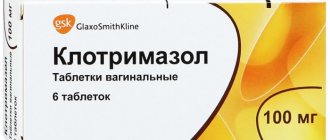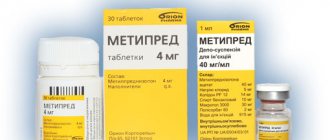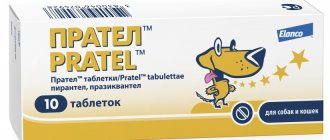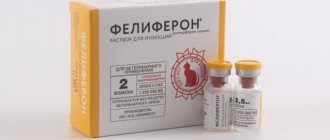Save the article:
When getting a little furry, you need to understand that caring for his health falls entirely on the shoulders of the owner. It happens that the cat catches an infection or has an allergic reaction. In such cases, veterinarians recommend the use of Dexamethasone.
Composition and release form
It is produced in the form of eye drops, ointments, tablets, injections, which makes it possible to choose the optimal treatment option.
Chemical composition of the drug
Injection
Produced in ampoules of 50 or 100 ml. The solution has a yellowish tint. 1 ml contains 2 mg of dexamethasone and additional components: sodium metabisulfite, water for injection and others.
Dexamethasone injections for cats
Pills
Packed in blisters of 10 pieces. One tablet contains 0.5 mg of the main substance and excipients: magnesium stearate, lactose and others.
Tablets after crushing with a spoon
Ophthalmic drops
Ophthalmic drops are a 0.1% dexamethasone solution. Packaged in bottles with a pipette of 5 or 10 ml. Prescribed for severe eye pathologies, when others are ineffective.
Mixing with water process
PDF -
Pdf - Certificates deksametazon
Storage conditions of the drug
The medicine must be stored in a safe place away from children and animals. The air temperature should be no higher than 25 degrees. You can also store the liquid in a syringe in the refrigerator, but no longer than 24 hours.
Important! Drops for eyes and ears come in a small bottle with a pipette at the tip. After the drug has been used, its shelf life in this form is no more than 30 days. Before you start using the drops, the bottle must be shaken thoroughly.
Purpose
1-2 ampoules of the product should always be on hand, as they may be needed suddenly, for example, with the development of shock or angioedema. It is also indicated for:
- arthritis, arthrosis;
- inflammation of the synovial bursa;
- intervertebral hernias;
- other pathologies of the musculoskeletal system;
- diseases of the adrenal glands;
- eczema;
- asthmatic status;
- lupus erythematosus;
- oncology;
- inflammatory processes that developed after injury.
Consequently, it is used for the development of pathologies of the nervous and respiratory systems, gastrointestinal tract, and skin.
In ampoules
When to use
According to the instructions for use, Dexamethasone for cats is usually used in the following cases:
- for arthritis, bursitis, intervertebral hernia and other pathologies of the musculoskeletal system;
- for eczema, allergic dermatitis;
- for bronchial asthma;
- with lupus erythematosus;
- in case of an allergic reaction to medications;
- for leukemia and other oncological diseases;
- for swelling and inflammation that develops as a result of injury;
- for allergies in any form, etc.
Note! A couple of ampoules of this drug should always be kept in the veterinary medicine cabinet, since it can be used to provide first aid for angioedema or anaphylactic shock. You should consult your doctor in advance regarding the dose.
The hormonal remedy is also used if the adrenal cortex does not secrete the necessary hormone. In this case, the treatment regimen and dosage of the medication should be carefully calculated by the doctor. Dexamethasone is also suitable for helping with shock and various injuries, including those received as a result of accidents or falls from a height. In this case, the drug has a complex effect - it has an anti-shock effect and prevents the development of symptoms (inflammation, swelling, etc.).
Eye drops are used for cats with the following pathologies of the organs of vision:
- with conjunctivitis;
- with keratitis;
- with blepharitis;
- with keratoconjunctivitis;
- for other eye diseases of non-infectious origin.
Drops can also be used for otitis media.
Instructions for use of Dexamethasone
The instructions describe in more detail all cases of use of the medication. The dose is selected strictly individually for each case and depends on the pathology, general condition of the cat, and the severity of symptoms.
As a rule, the medicine is prescribed simultaneously with other drugs that enhance the effect and speed up recovery. Most often it is combined with acetylsalicylic acid, rimadyl, digoxin and others. For infectious diseases, it is prescribed in combination with antibacterial therapy.
Injections
The dose is selected depending on the severity of symptoms and the weight of the animal. For example, in case of shock, it is used once at the rate of 1 kg of weight: 1.5 ml of product. It must be done intramuscularly or subcutaneously. Repeated administration is possible after a day. The entire required dose is administered at once. The duration of treatment is a maximum of 7 days. As a rule, it is used exclusively in emergency cases: states of shock, relapse of chronic diseases in the acute stage.
Dosage table
| Weight, kg | Single dosage, ml |
| Up to 2 | 0,2-2 |
| 2-3 | 0,3-3 |
| 3-5 | 0,5-5 |
Features of the use of eye drops
The medication is prescribed in drop form up to 5 times during the day, depending on the severity of the disease. Place a drop in each eye. In the acute form, improvement usually occurs within the first 2 days. In case of severe pathologies, the course is extended to 7 days, but no more than two weeks.
Step-by-step instruction:
- Initially, remove all discharge from the eyes with a cotton pad. It can be pre-moistened in boiled, cooled water.
- Pull back the lower eyelid and drip closer to the inner corner.
- After the drops get in, you should close your eyelid, blot away any excess medicine, and calm your pet.
Pills
Tablets should be given to your pet, strictly adhering to the prescribed dosage and time of administration.
However, they are used very rarely for the treatment of animals, since they are inferior in speed and effectiveness to injections. Moreover, not every pet will agree to calmly swallow bitter medicines. But for long-term therapy, preference is given to the tablet form at the rate of 0.1 mg of dexamethasone per kilogram of weight.
Contraindications and safety precautions
Of course, there is not a single medical drug that could have a noticeable effect and at the same time be completely safe. This also applies to Dexamethasone. In other words, there are a number of contraindications that must be taken into account when working with this product. Here they are:
- the presence of an allergic reaction or other kind of hypersensitivity to one of the components of this product (the composition can be read on the packaging; perform an allergy test before use);
- pathological processes developing in the animal’s visual system;
- last trimester of cat pregnancy.
In addition to contraindications, you should also pay attention to the so-called side effects that often follow the use of a particular drug.
Seizures in a cat are a dangerous side effect from using the drug in question.
In this case we are talking about:
- the occurrence of cramps in the animal’s paws;
- increased appetite and constant hunger;
- apathy, weakness;
- increased pressure inside the animal’s eyes;
- dyspeptic disorders: vomiting, loose stools;
- the appearance of shortness of breath;
- reducing the animal’s resistance to diseases of infectious and viral etiology;
- frequent and excessive urination, etc.
To avoid adding even more unpleasant consequences to this list, you must also follow safety precautions. It consists of the following rules.
Rule 1 . Work with the drug must be carried out sterile:
- hands (with gloves);
- syringes.
In other words, before you start working with the product, you need to wash your hands, treat them with an antiseptic, put on sterile (new) latex gloves and take a sterile (also new, sealed) syringe.
Use sterile instruments
Rule 2 . Provided that you are administering the drug to an animal by injection, you must:
- place the pet on a horizontal surface;
- secure the animal to prevent sudden movements.
Thus, the introduction of the product should be carried out extremely smoothly.
What do you need to know before injecting your cat?
Rule 3. As you remember, the body’s receipt of “Dexamethasone” leads to an imbalance in the endocrine system of the cat’s body, as well as in many systems. In other words, the body experiences a greater load, and it is more difficult for it to carry out all the tasks assigned to it. To make your work easier, you need to:
- properly care for the animal, that is, feed it with healthy foods, observe the drinking regime, room temperature, etc.;
- It is also important to establish a daily routine for the cat, in particular, give it sleep and gain strength.
Rule 4. To avoid side effects from the drug not only for the cat, but also for you, it is necessary to wash your face and hands after the treatment procedure.
For cleaning, it is recommended to use warm water and regular soap.
Rule 5 . During a medical procedure involving Dexamethasone, it is prohibited to eat, drink, or smoke.
Rule 6. Persons who are aware of their hypersensitivity to the drug should not come into direct contact with the drug.
Rule 7. Another precaution is to monitor your pet for allergies. Unfortunately, it is not uncommon for cats to react poorly to the prescribed drug. If you notice the development of negative symptoms in your pet, immediately contact your veterinarian for:
- relief of the observed clinical manifestation;
- selection of a drug with a similar effect.
Eye drops should not be used for the most trivial reasons - the damage to the organ of vision must be serious
Rule 8 . It is important not only to use it correctly, but also to store Dexamethasone correctly. So, you need to do this:
- in a room where the temperature does not rise above 25°C;
- inside any box, safe, chest, etc., where children cannot reach it;
- When the expiration date expires, the drug must be disposed of (after 5 years from the date of manufacture, tablets, drops, solution, etc. must be thrown away).
Video - How to put drops in a cat's eyes?
How it works
The main component is a synthetic hormone - an analogue of the adrenal hormone, which affects the functioning of almost all organs and systems.
Has the following effects:
- antiphlogistic;
- anti-shock;
- antiallergic;
- immunosuppressive;
- antitoxic.
The antiphlogistic effect is due to the fact that, upon penetrating the body, the main active component suppresses the production of substances that are involved in inflammatory processes. It also excellently suppresses certain types of receptors, which confirms its antiallergic effect, that is, the body does not react to the irritant. In this case, protective functions are suppressed.
It is for these reasons that it is used to relieve shock that has developed against the background of an allergy or after an injury, since it has an almost instantaneous effect.
pharmachologic effect
The medicine replaces the hormone Cortisol. It affects the body in several directions: it does not allow the combination of substances that cause inflammatory processes; has an anti-shock effect; increases the sensitivity of beta-adrenergic receptors; participates in protein production; helps produce enzymes necessary for normal life. After entering the blood, the drug component interacts with transcortin, a protein that plays a transport role. After processing by the liver, the active substance breaks down into inactive components. The drug is excreted from the body in 3 to 5 hours by the kidneys.
Interaction with other drugs
Not prescribed together with the following medications:
- antiallergic;
- antidiabetic;
- diuretics;
- glucocorticosteroids;
- immunobiological;
- barbiturates, salicylates;
- calcium salts and potassium-binding agents;
- tetracycline, macrolides, kanamycin.
Also, you should not take it with Praziquantel at the same time.
Side effects
Undesirable consequences are observed extremely rarely, with strict adherence to the recommended dosage. However, they can develop and be expressed in the form of a gag reflex, convulsive states, lethargy, shortness of breath, dyspeptic disorders, increased appetite, skin itching, heart rhythm disturbances, increased blood pressure, and behavioral changes. In addition, it has contraindications, which include:
- intolerance to components;
- renal and liver failure;
- diseases of the cardiovascular system.
It is prescribed with great caution to elderly pets and those with diabetes. It is not prescribed before or after vaccination for 3 weeks.
Dexamethasone eye drops
Overdose and possible adverse reactions
An overdose can occur immediately when the dose is exceeded by 2 or more times. The following are noted:
- change in behavior (lethargy, apathy, drowsiness);
- nausea, vomiting;
- increased appetite;
- increased water consumption;
- frequent urination (although less common with Dexamethasone than with other steroids);
- increased susceptibility to viral and bacterial infections;
- dyspnea;
- diarrhea;
- ulceration of the digestive tract.
To prevent withdrawal symptoms when you miss a dose, you must do the following:
- Give the dose as soon as possible.
- If it is already time for your next dose, skip the missed dose and continue with your regular schedule. Never give your pet two doses at once.
Although Dexamethasone for cats is generally safe and effective, it can cause side effects in cats.
Common adverse reactions are similar to those of an overdose. Arrhythmia, bradycardia, hypertension, convulsions, allergic reactions, and increased calcium excretion are also possible.
In a biochemical blood test, an overestimation of liver enzymes is observed. These changes are not a big deal, but in some cases, liver damage can be a more serious problem.
Sometimes cats develop stomach or intestinal ulcers that cause bloody diarrhea.
Long-term treatment can lead to thinning of the coat, muscle atrophy, fatty liver and behavioral changes.
Analogs
If your pet has contraindications or is intolerant to the components, then the medicine should be replaced with one similar in its principle of action. However, all this must be agreed upon with a veterinarian.
Comparison table
| Name | Release form | Indications | Contraindications | Side effects |
| Maxidex | Drops | Allergies, inflammatory processes | Infections of viral, fungal, bacterial etiology | Increased intraocular pressure |
| Pharmadex | Drops | Inflammation of non-infectious etiology, allergic reaction, conjunctivitis. | The same | Burning, hyperemia, itching of the conjunctiva |
| Dexacort | Drops | Conjunctivitis, trauma and redness of the cornea. | Hypersensitivity, viral and fungal diseases. | Irritation, burning, itching of the mucous membrane, increased intraocular pressure. |
| Decadron | Injections | Inflammation, shock, cerebral edema. | Intolerance, mycoses, vaccination. | Changes in water and electrolyte metabolism, musculoskeletal system and gastrointestinal tract. |
| Dexamed | Injections | Shock, acute hepatitis, cerebral edema, allergies. | Intolerance. | Nausea, diarrhea, lack of appetite. |
| Fortecortin | Injections | Shock states, status asthmaticus, edema. | Mycoses, hypersensitivity. | Increased appetite, obesity, decreased protective functions. |
One of the analogues is Maxidex
Opinion of owners and veterinarians
Reviews about the use of Dexamethasone in the treatment of cats are mostly positive. Owners of furry pets note the rapid effect of using the drug. And veterinarians use it in a variety of situations.
Dexamethasone works quickly and effectively, like magic. It has proven itself in the treatment of chronic allergic dermatitis. We give injections intramuscularly, for up to 7 days. Itching and dermatitis go away in cats once and for all! We also often use the drug for pulmonary edema, acute allergic reactions of unknown nature, and convulsions.
Lavrentyev S.V., veterinarian
I use Prednisolone instead of Dexamethasone. This is correct for cats. Dexamethasone causes withdrawal symptoms faster and more often. I don’t understand why Dexamethasone is prescribed to cats if there are more gentle drugs. We switched to methylprednisolone (this is not just Metypred).
Volosyakhina L.A., veterinarian
Among the advantages of Dexamethasone, I can note the rapid onset of a positive effect. We didn't notice any side effects. The economical price is also a plus.
Among the disadvantages, I can highlight that it is difficult to give a cat a pill. The medicine in tablets was prescribed to us by a veterinarian after all the tests. We were sent home for treatment; we don’t know how to give injections ourselves and we’re afraid, so they asked us to prescribe some pills.
Our cat has been suffering from a cough for several years. The doctor said he has asthma! We had no idea that cats get asthma just like humans. They thought he was constantly catching a cold somewhere. We have been giving Dexamethasone to the cat for only a week and have already felt the results - less coughing (especially at night), the pet has become more active and eats more. We'll go see the doctor again in 2 weeks! I recommend it to those whose pets are facing the same problem.
Natalya, 35 years old
Our cat fell from the 10th floor six months ago. There was a fracture of the hind leg. It constantly swelled while the knitting needles were on the bone. The veterinary clinic recommended a course of Dexamethasone.
Injections were given into the muscles on a healthy leg once a day for 14 days. The swelling disappeared after a couple of days, the duration of treatment continued as prescribed. Everything is great with our Marcel now!
Valentina, 42 years old
After analyzing the reviews, we can highlight the following advantages and disadvantages of the drug.
| Pros: | Minuses: |
|
|
Dexamethasone reviews
Elena, Moscow. The effectiveness of this remedy had to be tested under unpleasant circumstances. Our favorite, lop-eared Max, was hit by a car. His condition worsened every minute. He was convulsing and foam was coming out of his mouth. We rushed to the clinic, fortunately it was 2 houses away from us. The veterinarian immediately gave a miracle injection and the cat returned to normal. True, further long-term treatment was required, but we managed. Max is fine now.
Katerina, Magnitogorsk. Our cat was prescribed it for urolithiasis, after catheterization. They injected me for several days and took other medications. No side effects were observed. Now Murzik is alive and healthy. We really watch our diet.
Roman, veterinarian. In extreme cases, I resort to hormones, as they have a huge list of side effects. But in certain situations you cannot do without them. I consider dexamethasone the best glucocorticosteroid, which is not so expensive.
To summarize, we can say that Dexamethasone for cats is an effective medication for relieving inflammatory processes. Its effectiveness is due to the high activity of the main component, which means it easily helps to achieve a good therapeutic effect. But, it should be taken only in a strictly prescribed dosage, so as not to harm the pet.
Where and how to inject Dexamethasone
The Dexamethosone injection requires compliance with several simple rules. First, the intended injection site is examined; the skin should be healthy. No processing needed.
You cannot mix different drugs in one syringe!
The exact dose will be determined by the veterinarian; approximately 0.1-0.5 ml is taken.
How is the human medicine Dexamethasone used in treating cats?
A good immune system is an important component in the fight against various diseases.
But in some situations, even with good immunity, the inflammatory reaction in the body can lead to serious damage to tissues and organs.
Also, the immune system, often for no apparent reason, can attack its own body, causing enormous damage to health and even death. This condition is called “autoimmune diseases”.
There are a number of medications available to combat inflammation and suppress immune system overreaction. Among the most well-known are steroid hormones related to cortisone (the stress hormone).
Dexamethasone is a powerful glucocorticosteroid (GCS), that is, a hormone related to cortisone (which is produced by the adrenal glands). The effect of such GCS is clearly visible.
But these drugs, due to their strong effects, should be used only when justifiably necessary.
General information about the drug
The main active ingredient is dexamethasone sodium phosphate.
Most often in veterinary medicine, Dexamethasone for cats is used in the form of an injection solution in ampoules of 2 mg/ml (0.2%). Additional components of this form of the drug are:
- Glycerin is used to dissolve the active substance in water.
- Sodium phosphate dihydrate is used to create an optimal pH environment for the drug.
- Sodium edetate promotes the distribution of the drug in all organs and tissues.
- Water for injection , as a formative medium for medicine, is non-toxic, pyrogen-free (does not cause an increase in temperature).
The drug is also available in the form of tablets and eye drops. Additional components in the tablet form of the drug are lactose, starch, povidone, magnesium stearate, talc, dry silicon dioxide. And in the drops, boric acid, sodium tetraborate, Trilon B, a preservative and injection water act as excipients.
Operating principle
Dexamethasone has a more pronounced steroid effect than other organic hormones of the adrenal cortex, cortisol derivatives. It has effective immunosuppressive, antiallergic and anti-inflammatory effects. The pharmacological action is realized by suppressing inflammatory mediators and prostaglandins released during cell destruction.
The drug potentiates sensitive receptors of immune cells (phagocytes), reducing their destructive effect on the cells of one’s own body. Inhibits the synthesis of immunoglobulins and macrophages, reduces the activity of T-lymphocytes and their number.
Including, it has a fast onset and duration of effect. After intramuscular injection, the active substance is absorbed into the blood within 10-15 minutes. Tablets are absorbed more slowly and provide a long-lasting effect. The absolute concentration of the substance in the bloodstream is detected after 1 hour.
The therapeutic concentration in the blood serum lasts up to 4 days in cats, depending on the condition of the internal organs. Bioavailability when administered parenterally reaches 100%, when administered orally – 50-60%. The drug is metabolized in the liver. And they are excreted primarily through the filtration system of the kidneys with urine.
When using eye drops, the medicine retains its effect for 4 hours.
The mechanism of action of corticosteroids manifests itself at the cellular level. GCS easily penetrates the double lipid membrane of sensitive cells. The cytoplasm of dexamethasone-sensitive cells binds drug receptors.
These cell-substance connections contribute to the main anti-inflammatory and anti-allergic effects. Together with the main effect, GCS also affect all types of metabolism: protein, carbohydrate (glucose metabolism), lipid, mineral and water-salt.
This influence can be both beneficial and harmful.
Since steroid hormone receptors are present in all types of tissues, they can be considered to have an effect on almost all cellular systems of the animal body.
Dexamethasone is given to cats to treat pathological conditions of an allergic, inflammatory and autoimmune nature. It helps achieve positive dynamics in treatment:
Indications for treating animals with medicine in the form of eye drops are conjunctivitis, inflammation of the ciliary zone and tear ducts and other diseases of the organs of vision. This drug is often prescribed after surgery by an ophthalmologist. It relieves allergic manifestations such as swelling, itching, and redness well.
Conjunctivitis Inflammation of the ciliary zone Eczema Dermatitis
Contraindications to the use of the drug in cats are:
- pregnancy and lactation;
- young age, not yet reached puberty;
- individual intolerance to components;
- bone fracture.
The medicine is used with caution in veterinary practice to treat cats with the following diseases:
- renal pathologies (with the exception of glomerulonephritis);
- heart failure;
- osteoporosis;
- hyperadrenocorticism (Cushing's syndrome);
- fungal and acute viral infections;
- diabetes;
- ulcer of the stomach and duodenum.
Instructions for the use of Dexamethasone in veterinary medicine for the treatment of cats
The dose of medication in veterinary medicine varies depending on the pathology. It is determined based on the severity of the disorder, the condition of the body and the duration of therapy.
Anti-inflammatory injection doses for cats range from 0.1 to 0.5 mg per kilogram up to twice daily.
The immunosuppressive dosage for a cat can be from 1 to 6 mg per kilogram up to three times a day.
The course of treatment depends on the pathological condition, response to the drug and the development of any adverse effects.
Even if your pet begins to feel better immediately, the treatment plan must be followed through to completion. This will minimize the risks of relapse and prevent the development of withdrawal syndrome. Withdrawal syndrome is a sharp return of all symptoms of a previous disease due to early drug withdrawal.
Dexamethasone is prescribed to kittens upon reaching puberty. That is, approximately 7-9 months. The course of treatment is determined by the doctor depending on the pathology. The risk of side effects is higher in kittens.
Before using the drug in the form of ophthalmic drops, shake the bottle and rinse your eyes. Apply the drug at room temperature to the inner corner of the eye. The procedure is repeated 3-5 times a day. The duration of treatment is determined by the veterinarian. On average, the course of treatment is no more than 14 days.
This medication should never be used without first consulting your veterinarian.
An overdose can occur immediately when the dose is exceeded by 2 or more times. The following are noted:
- change in behavior (lethargy, apathy, drowsiness);
- nausea, vomiting;
- increased appetite;
- increased water consumption;
- frequent urination (although less common with Dexamethasone than with other steroids);
- increased susceptibility to viral and bacterial infections;
- dyspnea;
- diarrhea;
- ulceration of the digestive tract.
To prevent withdrawal symptoms when you miss a dose, you must do the following:
- Give the dose as soon as possible.
- If it is already time for your next dose, skip the missed dose and continue with your regular schedule. Never give your pet two doses at once.
Although Dexamethasone for cats is generally safe and effective, it can cause side effects in cats.
Common adverse reactions are similar to those of an overdose. Arrhythmia, bradycardia, hypertension, convulsions, allergic reactions, and increased calcium excretion are also possible.
In a biochemical blood test, an overestimation of liver enzymes is observed. These changes are not a big deal, but in some cases, liver damage can be a more serious problem.
Sometimes cats develop stomach or intestinal ulcers that cause bloody diarrhea.
Long-term treatment can lead to thinning of the coat, muscle atrophy, fatty liver and behavioral changes.
Interaction with other drugs
Dexamethasone reduces the effectiveness of insulin drugs and hypoglycemic drugs. When taken in parallel with diuretics, potassium excretion increases.
When used simultaneously with non-hormonal anti-inflammatory drugs (including aspirin), ulcers and bleeding in the gastrointestinal tract may occur. It is also possible to reduce the anticoagulant effect when taking a drug with this effect.
The effect of Dexamethasone may be reduced when combined with rifampicin, aminoglutethimide, phenytoin, carbamazepine, and barbiturates.
This medicine should not be taken together with vaccines, as this drug can suppress artificially formed immunity.
Opinion of owners and veterinarians
Reviews about the use of Dexamethasone in the treatment of cats are mostly positive. Owners of furry pets note the rapid effect of using the drug. And veterinarians use it in a variety of situations.
Dexamethasone works quickly and effectively, like magic. It has proven itself in the treatment of chronic allergic dermatitis. We give injections intramuscularly, for up to 7 days. Itching and dermatitis go away in cats once and for all! We also often use the drug for pulmonary edema, acute allergic reactions of unknown nature, and convulsions.
Lavrentyev S.V., veterinarian
I use Prednisolone instead of Dexamethasone. This is correct for cats. Dexamethasone causes withdrawal symptoms faster and more often. I don’t understand why Dexamethasone is prescribed to cats if there are more gentle drugs. We switched to methylprednisolone (this is not just Metypred).
Volosyakhina L.A., veterinarian
Among the advantages of Dexamethasone, I can note the rapid onset of a positive effect. We didn't notice any side effects. The economical price is also a plus.
Among the disadvantages, I can highlight that it is difficult to give a cat a pill. The medicine in tablets was prescribed to us by a veterinarian after all the tests. We were sent home for treatment; we don’t know how to give injections ourselves and we’re afraid, so they asked us to prescribe some pills.
Our cat has been suffering from a cough for several years. The doctor said he has asthma! We had no idea that cats get asthma just like humans. They thought he was constantly catching a cold somewhere.
We have been giving Dexamethasone to the cat for only a week and have already felt the results - less coughing (especially at night), the pet has become more active and eats more.
We'll go see the doctor again in 2 weeks! I recommend it to those whose pets are facing the same problem.
Natalya, 35 years old
Our cat fell from the 10th floor six months ago. There was a fracture of the hind leg. It constantly swelled while the knitting needles were on the bone. The veterinary clinic recommended a course of Dexamethasone.
Injections were given into the muscles on a healthy leg once a day for 14 days. The swelling disappeared after a couple of days, the duration of treatment continued as prescribed. Everything is great with our Marcel now!
Valentina, 42 years old
After analyzing the reviews, we can highlight the following advantages and disadvantages of the drug.
| Pros: | Minuses: |
|
|
How much does it cost and what are the conditions of sale and storage?
The price of Dexamethasone in the form of an injection solution varies from 150 to 300 rubles per package. In tablet form - from 50 to 100 rubles per blister. The drug is suitable for treating animals, but can be purchased in regular pharmacies with a prescription from a veterinarian.
The medicine should be stored in a tightly closed container at room temperature, protected from light.
Use of Dexamethosone in the form of drops
They are prescribed by veterinarians to get rid of non-purulent conjunctivitis, ketaritis, uveitis, etc. These eye drops can relieve allergic processes and enhance the healing of prolonged wounds after corneal injuries and after eye surgeries.
Under no circumstances should such treatment be prescribed if the diagnosis has not been clarified. And in general, their purpose requires justification. Unreasonable use of dexamethasone drops as a therapeutic drug threatens the most unpleasant complications.
Complications from the unreasonable prescription of Dexamethasone for eye lesions
- When the drug is prescribed to treat a fresh superficial injury, erosion may increase and may occupy the entire surface of the cornea if use is prolonged. Withdrawal of the drug often leads to increased lacrimation. So weaker steroids, such as hydrocortisone, are prescribed with parallel administration of antibacterial agents. If the animal has been injured by cat claws, complications from Dexamethasone are most severe.
- Under the influence of the drug during a viral infection, the process can further spread. Even corneal swelling, blisters and swellings are often observed. And then treatment should be carried out with antiviral drugs that contain acyclovir, such as Zovirax ointment, and immune drugs.
- Often, with minor injuries to the cornea, as well as with long-term treatment with antibiotics, infection with a fungus occurs. Taking Dexamethasone can lead to the spread of the process. In this case, Colbiocin, a combination drug with an antifungal component, has proven itself quite well.
- Long-term use of Dexamethasone drops sometimes leads to steroid-induced glaucoma. Only cancellation allows you to save the eye in such a development of events. Okupres or Okumed normalize intraocular pressure within a month. But the likelihood of a secondary infection remains high.
Video on the topic:
[smartcontrol_youtube_shortcode key=”Cat diseases” cnt=”2" col=”2" shls=”false”]
general characteristics
The production of Dexamethasone is carried out by several pharmaceutical companies (Belarus), KRKA (Slovenia), Alfasan International (Netherlands) and others. The drug is a transparent yellowish or colorless solution with a slight specific odor. The medicine is packaged in glass ampoules of 1 or 2 ml.
The manufacturer recommends storing the drug away from feed and food, in a place where animals and small children cannot reach. The packaging should not be heated to a temperature of 25 °C or higher. If these conditions are met, the medicine retains its pharmaceutical properties for 3 years. After this period, unused remains of the solution must be disposed of.
Restrictions
Cats should not take tablets or give Dexamethasone injections in the following cases:
- for diabetes mellitus;
- with hypersensitivity to components;
- during pregnancy;
- during lactation;
- for osteoporosis.
You should not use a hormonal drug for kittens during the formation of the bone skeleton. The fact is that when it is used, calcium is washed out of the body, so the bones become fragile. For the same reason, you should not inject the drug for fractures.
If the animal has heart, kidney or liver disease, consult a veterinarian. In most cases, it is better to stop using the product, otherwise complications may develop. In addition, the medication cannot be combined with certain types of antibiotics, antiallergic and painkillers, and other medications. Complex therapy should be selected by a doctor.











